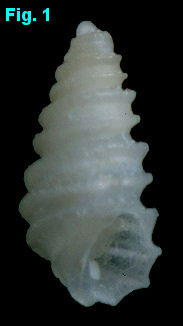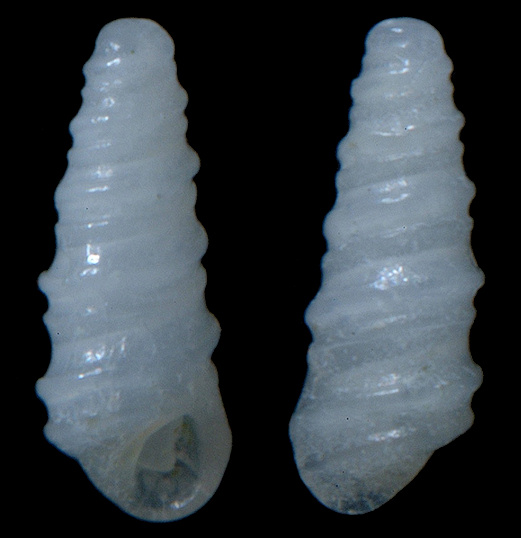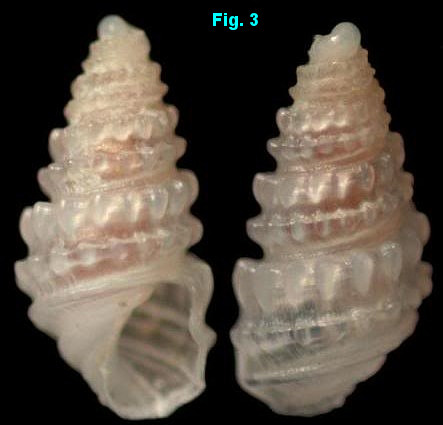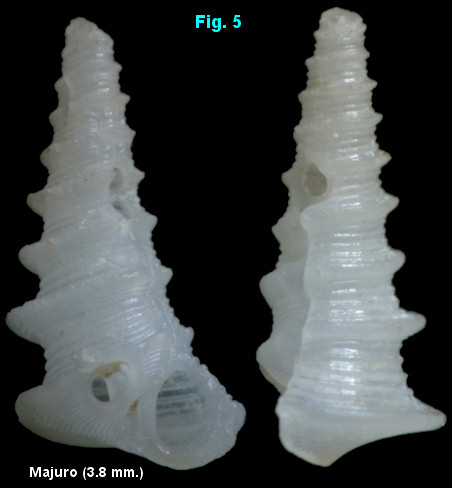|
Pyramidelloides carinatus (Mørch, 1876) |
|
|
|
|
|
Drift from Sandy Spit off Jost van Dyke, British Virgin Islands (2 mm.). Digital Images by David Kirsh. |
|
|
Pyramidelloides: a protean parasite pretending to be a pyram |
|
|
by Harry G. Lee  The shells of Pyramidelloides Nevill, 1885
(Prosobranchia: Eulimidae) have been acknowledged as atypical from the
birth of the nominal taxon. Nevill's selection of the name clearly
indicates its similarity to the pyrams (Heterobranchia: Pyramidellidae),
with which family he recognized it was not related (and presently not
even of the same Subclass). The Caribbean pyram, Pseudoscilla
babylonia (C.B. Adams, 1845) [Fig. 1], exemplifies this similarity in
the case of P. carinatus above. Likewise Pyramidelloides
mirandus (A. Adams, 1861) [Fig. 2], the only species Nevill assigned to
his genus and interestingly also collected by David - but in a remote
part of Micronesia, converges on the Caribbean pyram Liomorpha
decorata (de Folin, 1873)* [Fig. 3]. Although there are a host of
biological differences in these pairs, the most salient conchological
one is the radical change in the direction of coil between the larval
and adult shells. This realignment of the coiling axis is reflected in
the tipping of the spire's apex - evident in these two pyram shells but
not seen in the two belonging to the topical genus, which have
monotonously orderly growth from the earliest shell onward. The shells of Pyramidelloides Nevill, 1885
(Prosobranchia: Eulimidae) have been acknowledged as atypical from the
birth of the nominal taxon. Nevill's selection of the name clearly
indicates its similarity to the pyrams (Heterobranchia: Pyramidellidae),
with which family he recognized it was not related (and presently not
even of the same Subclass). The Caribbean pyram, Pseudoscilla
babylonia (C.B. Adams, 1845) [Fig. 1], exemplifies this similarity in
the case of P. carinatus above. Likewise Pyramidelloides
mirandus (A. Adams, 1861) [Fig. 2], the only species Nevill assigned to
his genus and interestingly also collected by David - but in a remote
part of Micronesia, converges on the Caribbean pyram Liomorpha
decorata (de Folin, 1873)* [Fig. 3]. Although there are a host of
biological differences in these pairs, the most salient conchological
one is the radical change in the direction of coil between the larval
and adult shells. This realignment of the coiling axis is reflected in
the tipping of the spire's apex - evident in these two pyram shells but
not seen in the two belonging to the topical genus, which have
monotonously orderly growth from the earliest shell onward.Another convergence is on the Rissoidae, as exemplified by the Caribbean Alvania arubensis De Jong and Coomans, 1988 [Fig. 4]. In fact Nevill introduced Pyramidelloides as a subgenus of Rissoa, where it remained for very nearly a century. Only after examination of the soft anatomy and habits (a parasite of brittlestars) of the type species, P. mirandus, was Warén (1983) compelled to transfer the genus to the Eulimidae, a distant (but not nearly as distant as the Pyramidellidae) relative of the rissoids. Eulimids are usually smooth and shiny, even slippery in texture, but a few sculptured genera are known, such as the bizarre Bacula morisyuichiroi (Habe, 1968) [Fig. 5]: - you guessed it: also collected by David in Micronesia. There is another conchological curve in the pitching repertory of Pyramidelloides. A while back I mentioned to David that his Micronesian shell was stouter than the type of Rissoa miranda. Shortly afterward, we were interested to find that Warén (1983: 289, 292) noted that there were two morphs in most samples of this species, and the stout ones were the females! Pyramidelloides carinatus is represented in my collection by lots from Turks and Caicos, Puerto Rico, and the Virgin Is. Besides these localities, Faber (1990: 110) listed St. Martin; he also discussed the loss of the apical whorl in presumably female shells (Faber, 1990: 112) of this and a congener. Thus another conchological disguise employed by the protean Pyramidelloides has been revealed - and It seems that David once again has a landed female specimen as the early portion of his shell has clearly undergone remodeling from the normally acuminate apex to a fat, blunt one. |
|
|
|
|
| The reader has probably taken note of my combination of the species epithet "carinatus" with Pyramidelloides, employing the masculine termination, "-us." This grammatical construct is in compliance with Article 30.1.4.4 of the Code (ICZN, 1999), which mandates that each -oides [o is presently Roman, not italic] generic level taxon is to be treated as masculine "unless its author, when establishing the name, stated that it had another gender or treated it as such by combining it with an adjectival species-group name in another gender form." Nevill (1885: 95) introduced Pyramidelloides as a subgenus of Rissoa and made no statement of the gender of his nov. subgen., Article 30.1.4.4 is applied without reservation. One might then inquire: "Why not use 'P. miranda' for the type species (above) rather than 'P. mirandus', e.g., Robba et al, 2002)? The reason is that "miranda," despite appearances, is not a proper name to be placed in apposition; as did Warén (1983, 1984). The fact is mirandus, -a, -um is a Latin adjective - meaning admirable. If it were a proper name, Arthur Adams would have capitalized the epithet in the original description of Rissoa miranda at <https://biodiversitylibrary.org/page/15602164> as he did in the case of Alvania Mariella [sic] three pages later at <https://biodiversitylibrary.org/page/15602167>. | |
|
|
|
|
* Usually identified as Miralda [or Ividia]
havanensis (Pilsbry and Aguayo,
1933), a junior synonym. Faber, M., 1990. Studies on West Indian Marine mollusks 18. TA review of the genus Pyramidelloides [sic; Roman] (Gastropoda [sic; no colon] Prosobranchia: Eulimidae) in the West Indies, with the description of two new species. Basteria 54: 105-113. ICZN (International Commission for Zoological Nomenclature), 1999. International code of zoological nomenclature fourth edition. I.C.Z.N., London. pp. 1-306 + i-xxix. On-line at: < http://www.nhm.ac.uk/hosted-sites/iczn/code/index.jsp>. Nevill, G., "1884" [1885], Gastropoda. Prosobranchia-Neurobranchia. Hand List of Mollusca in the Indian Museum, 2. Order of the Trustees, Calcutta. 306 pp. On-line at: < http://www.nhm.ac.uk/hosted-sites/iczn/code/index.jsp>. Robba, E., I. DiGeronimo, N. Chaimanee, M. Negri, and R. Sanfilippo, 2002. Holocene and Recent soft-bottom mollusks from the northern Gulf of Thailand area: Bivalvia. Bolletino Malacologico 38(5-8): 49-132 (incl. 21 full p. B&W pls.).
Warén, A., 1983. An
anatomic description of Eulima bilineata Alder with remarks on
and a revision of Pyramidelloides Nevill (Mollusca, Probranchia,
Eulimidae). Zoologica Scripta 12(4): 273-294. October. [abstract
at
<https://onlinelibrary.wiley.com/doi/pdf/10.1111/j.1463-6409.1983.tb00511.x>} |
|




